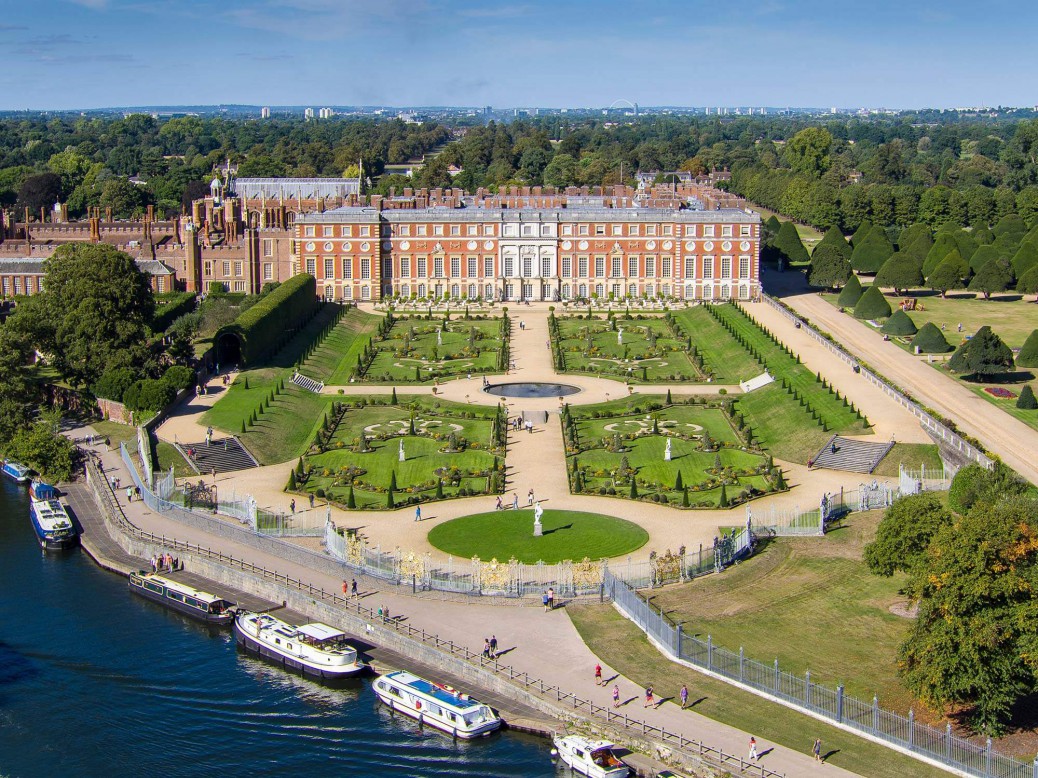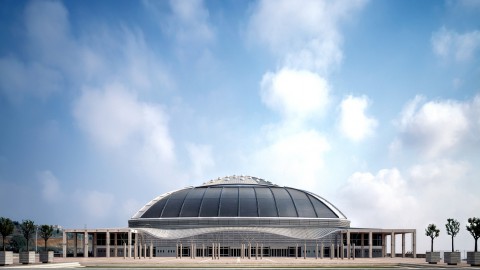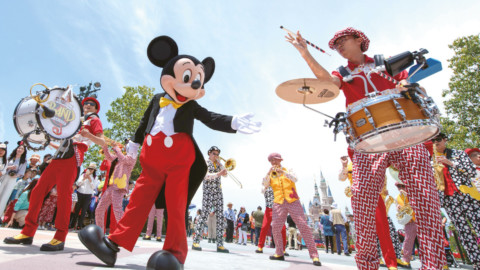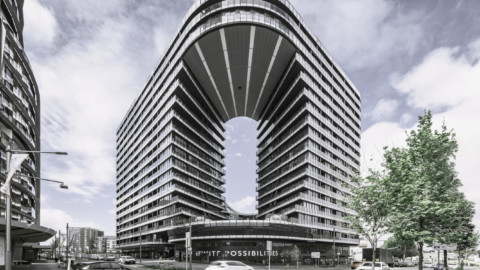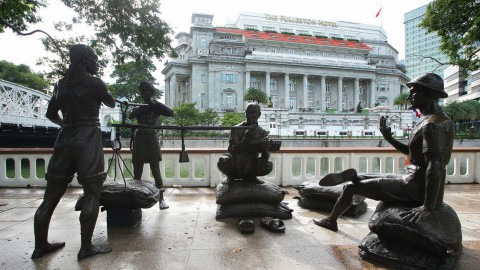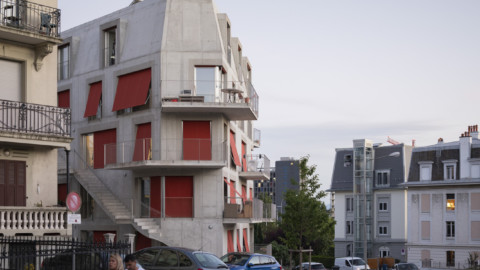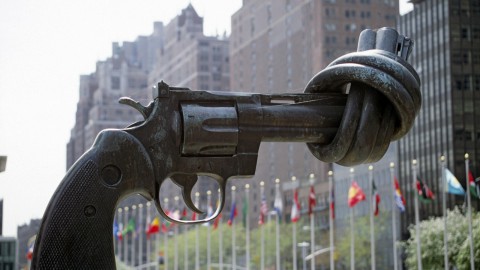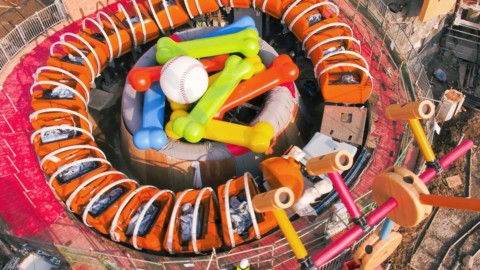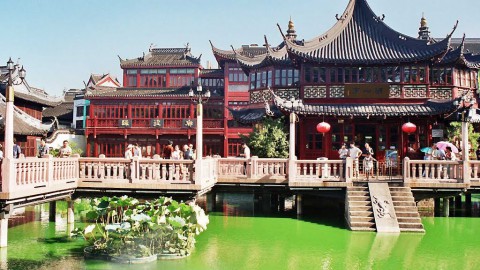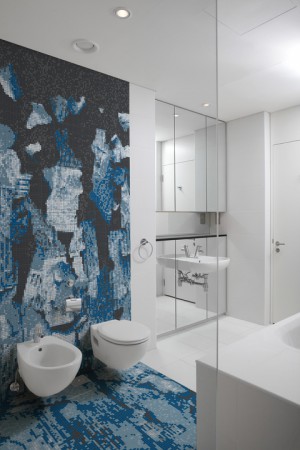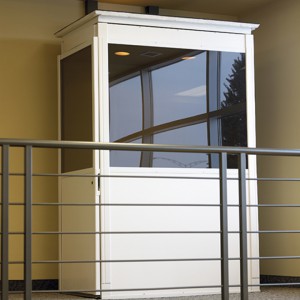Hampton Court Palace 漢普頓宮
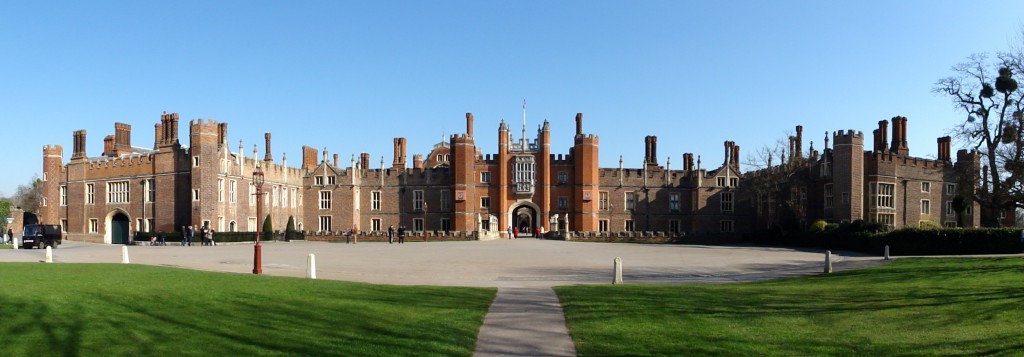
Hampton Court Palace is a royal palace in the borough of Richmond upon Thames, 12 miles (19.3 kilometres) south west and upstream of central London on the River Thames. Building of the palace began in 1515 for Cardinal Thomas Wolsey, a favourite of King Henry VIII. In 1529, as Wolsey fell from favour, the cardinal gave the palace to the King to check his disgrace; Henry VIII later enlarged it. Along with St James’s Palace, it is one of only two surviving palaces out of the many owned by King Henry VIII.
In the following century, King William III’s massive rebuilding and expansion work, which was intended to rival Versailles, destroyed much of the Tudor palace. Work ceased in 1694, leaving the palace in two distinct contrasting architectural styles, domestic Tudor and Baroque. While the palace’s styles are an accident of fate, a unity exists due to the use of pink bricks and a symmetrical, if vague, balancing of successive low wings. King George II was the last monarch to reside in the palace.
Today, the palace is open to the public and a major tourist attraction, easily reached by train from Waterloo station in central London and served by Hampton Court railway station in East Molesey, in Transport for London’s Zone 6. In addition, London Buses routes 111, 216, 411 and R68 stop outside the palace gates. The structure and grounds are cared for by an independent charity, Historic Royal Palaces, which receives no funding from the Government or the Crown. In addition the palace continues to display a large number of works of art from the Royal Collection.
Apart from the Palace itself and its gardens, other points of interest for visitors include the celebrated maze, the historic real tennis court (see below), and the huge grape vine, the largest in the world as of 2005.
The palace’s Home Park is the site of the annual Hampton Court Palace Festival and Hampton Court Palace Flower Show.
漢普頓宮是泰晤士河畔里士滿自治市的皇宮,位於泰晤士河西南12英里(19.3公里),倫敦市中心上游。宮殿的建造始於1515年,紅衣主教托馬斯沃爾西,亨利八世國王的最愛。 1529年,隨著沃爾西的失寵,紅衣主教將宮殿交給國王來檢查他的恥辱;亨利八世後來擴大了它。與聖詹姆斯宮一起,它是亨利八世所擁有的眾多宮殿中僅有的兩座倖存宮殿之一。
在接下來的一個世紀裡,威廉三世的大規模重建和擴建工作旨在與凡爾賽相媲美,摧毀了都鐸王朝的大部分宮殿。工作在1694年停止,使宮殿與兩個截然不同的建築風格,國內都鐸王朝和巴洛克風格。雖然宮殿的風格是命運的意外,但由於使用粉紅色的磚塊和對稱的,如果模糊的,連續的低翼平衡,存在統一。喬治二世國王是最後一位居住在宮殿裡的君主。
如今,這座宮殿向公眾開放,是一個主要的旅遊景點,可以從倫敦市中心的滑鐵盧火車站乘坐火車輕鬆抵達,並在東莫萊西的漢普頓火車站,倫敦6區的交通工具中服務。此外,倫敦公共汽車路線111 ,216,411和R68在宮殿門外停下。這個結構和場地由一個獨立的慈善機構 – 歷史皇家宮殿(Royal Royal Palaces)照顧,該機構不接受政府或官方的資助。此外,宮殿繼續展出皇家收藏品的大量藝術品。
除了宮殿本身及其花園外,遊客還可以參觀其他景點,包括著名的迷宮,歷史悠久的真正網球場(見下文),以及截至2005年世界上最大的葡萄藤。
宮殿的家庭公園是一年一度的漢普頓宮廷節和漢普頓宮花卉展覽的場地。
General information
Location:Hampton Court, Greater London, England
Coordinates:51°24′12″N 0°20′15″WCoordinates: 51°24′12″N 0°20′15″W
Current tenants:Historic Royal Palaces
Owner:Queen Elizabeth II in right of the Crown
一般信息
地點:英國大倫敦漢普頓宮
坐標:51°24’12“N 0°20’15”W坐標:51°24’12“N 0°20’15”W
現有租戶:歷史悠久的皇家宮殿
所有者:英國女王伊麗莎白二世
The country’s most eminent architect, Sir Christopher Wren, was called upon to draw the plans, while the master of works was to be William Talman. The plan was for a vast palace constructed around two courtyards at right angles to each other. Wren’s design for a domed palace bore resemblances to the work of Jules Hardouin Mansart and Louis Le Vau, both architects employed by Louis XIV at Versailles. It has been suggested, though, that the plans were abandoned because the resemblance to Versailles was too subtle and not strong enough; at this time, it was impossible for any sovereign to visualise a palace that did not emulate Versailles’ repetitive Baroque form.However, the resemblances are there: while the façades are not so long as those of Versailles, they have similar, seemingly unstoppable repetitive rhythms beneath a long flat skyline. The monotony is even repeated as the façade turns the corner from the east to the south fronts. However, Hampton Court, unlike Versailles, is given an extra dimension by the contrast between the pink brick and the pale Portland stone quoins, frames and banding. Further diversion is added by the circular and decorated windows of the second floor mezzanine. This theme is repeated in the inner Fountain Court, but the rhythm is faster and the windows, unpedimented on the outer façades, are given pointed pediments in the courtyard; this has led the courtyard to be described as “Startling, as of simultaneous exposure to a great many eyes with raised eyebrows.”
該國最傑出的建築師克里斯托弗·雷恩爵士被要求制定計劃,而作品大師則是威廉·塔爾曼。計劃是圍繞兩個庭院建造的一個巨大的宮殿,彼此成直角。 Wren的圓頂宮殿設計與Jules Hardouin Mansart和Louis Le Vau的作品相似,這兩位都是路易十四在凡爾賽宮僱用的建築師。但有人建議放棄這些計劃,因為與凡爾賽的相似之處太過微妙而且不夠強大;在這個時候,任何一個主權者都無法想像一個不能模仿凡爾賽重複巴洛克形式的宮殿。但是,相似之處在於:雖然外牆不像凡爾賽宮那麼長,但它們具有相似的,看似不可阻擋的重複性長長的平坦天際線下的節奏。當立面從東面向南面轉彎時,單調甚至重複。然而,與凡爾賽宮不同,漢普頓宮殿通過粉紅色磚和淡淡的波特蘭石頭形狀,框架和條帶之間的對比給予了額外的維度。二樓夾層的圓形和裝飾窗戶增加了進一步的轉移。這個主題在噴泉內部重複,但節奏更快,在外立面上沒有窗戶的窗戶在庭院中被給予尖銳的山形牆;這導致庭院被描述為“令人吃驚,同時接觸到許多眉毛抬起的眼睛。”
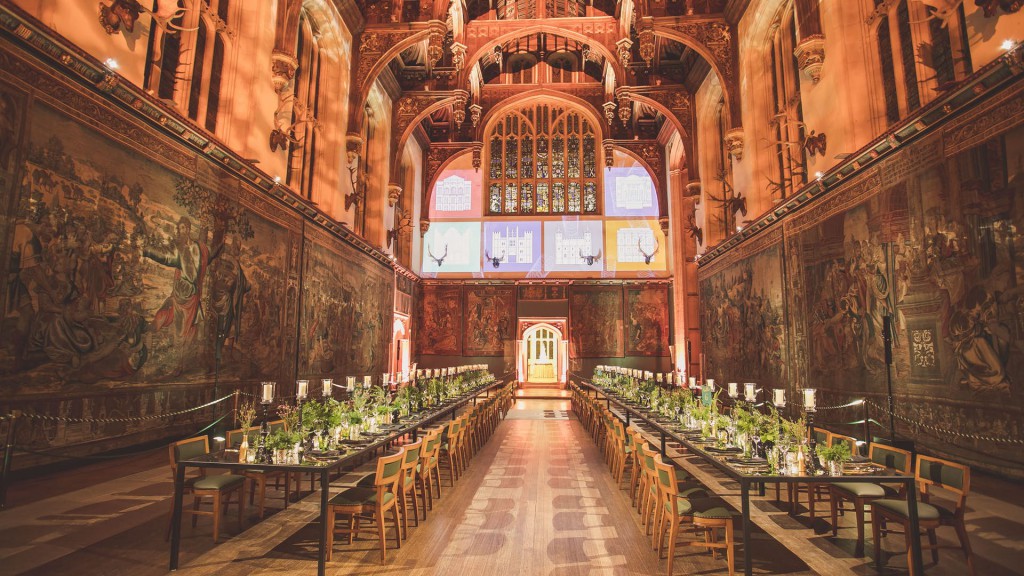
The palace houses many works of art and furnishings from the Royal Collection, mainly dating from the two principal periods of the palace’s construction, the early Tudor (Renaissance) and late Stuart to early Georgian period. In September 2015, the Royal Collection recorded 542 works (only those with images) as being located at Hampton Court, mostly paintings and furniture, but also ceramics and sculpture. The full current list can be obtained from their website.The single most important work is Mantegna’s Triumphs of Caesar housed in the Lower Orangery. The palace once housed the Raphael Cartoons now kept at the Victoria and Albert Museum. Their former home, the Cartoon Gallery on the south side of the Fountain Court, was designed by Christopher Wren; copies painted in the 1690s by a minor artist, Henry Cooke, are now displayed in their place. Also on display are important collections of ceramics, including numerous pieces of blue and white porcelain collected by Queen Mary II, both Chinese imports and Delftware.
Much of the original furniture dates from the late 17th and early 18th centuries, including tables by Jean Pelletier, “India back” walnut chairs by Thomas Roberts and clocks and a barometer by Thomas Tompion. Several state beds are still in their original positions, as is the Throne Canopy in the King’s Privy Chamber. This room contains a crystal chandelier of circa 1700, possibly the first such in the country.
The King’s Guard Chamber contains a large quantity of arms: muskets, pistols, swords, daggers, powder horns and pieces of armour arranged on the walls in decorative patterns. Bills exist for payment to a John Harris dated 1699 for an arrangement believed to be that still seen today.
宮殿收藏了許多皇家收藏品的藝術品和家具,主要可以追溯到宮殿建築的兩個主要時期,早期的都鐸王朝(文藝復興時期)和斯圖爾特晚期到格魯吉亞早期。 2015年9月,皇家收藏館錄製了542件作品(僅限有圖像的作品),位於漢普頓宮,主要是繪畫和家具,還有陶瓷和雕塑。完整的最新名單可以從他們的網站上獲得。最重要的一項工作是Mantegna位於Lower Orangery的Caesar勝利。這座宮殿曾經收藏過拉斐爾漫畫,現在保存在維多利亞和阿爾伯特博物館。他們的故居,噴泉苑南側的卡通畫廊,由克里斯托弗雷恩設計;由一位未成年藝術家亨利庫克於19世紀90年代繪製的複製品現在在他們的位置展出。同時展出的還有重要的陶瓷收藏品,包括Queen Mary II收集的大量青花瓷,包括中國進口和Delftware。
大部分原始家具的歷史可以追溯到17世紀末和18世紀初,包括Jean Pelletier的桌子,Thomas Roberts的“印度背”胡桃木椅子和Thomas Tompion的鐘錶。幾張國家床仍處於原始位置,國王樞密院的王座天篷也是如此。這個房間包含一個大約1700年的水晶吊燈,可能是該國第一個這樣的吊燈。
國王的警衛室包含大量的武器:火焰,手槍,劍,匕首,粉末角和裝飾圖案在牆壁上佈置的盔甲。條例草案的存款是為了支付約翰哈里斯(John Harris)的日期為1699年,因為這種安排被認為是今天仍然可見的。
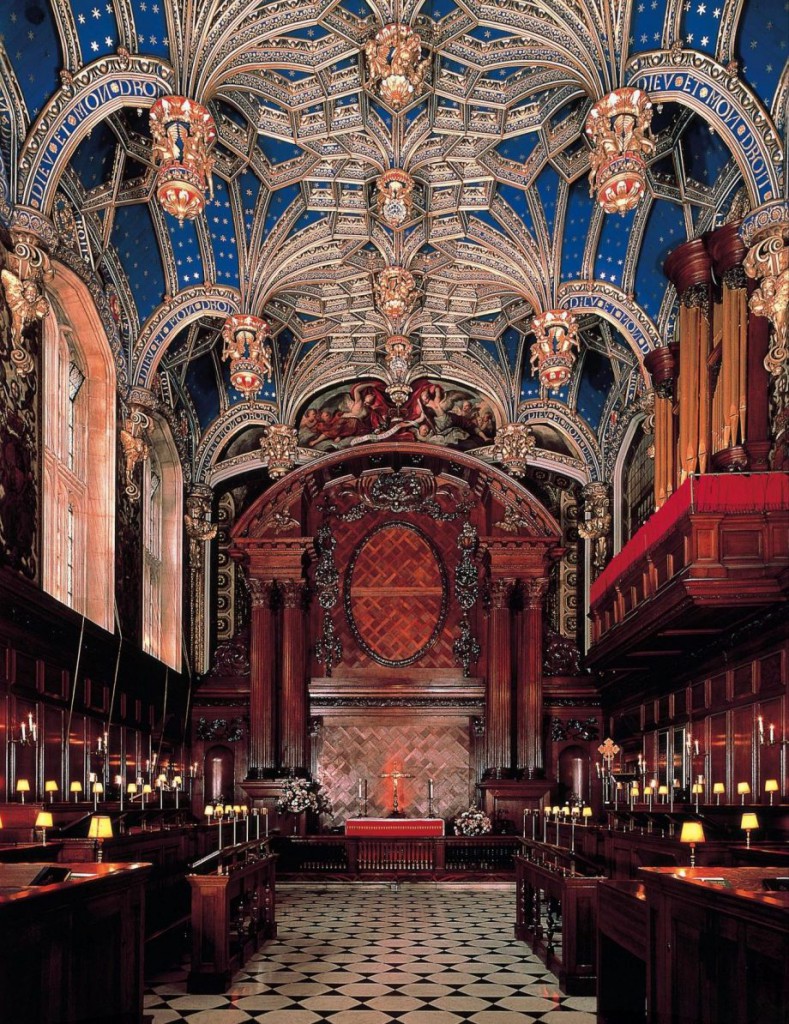
The timber and plaster ceiling of the Chapel is considered the “most important and magnificent in Britain”, but is all that remains of the Tudor decoration, after redecoration supervised by Sir Christopher Wren. The altar is framed by a massive but plain oak reredos with garlands carved by Grinling Gibbons during the reign of Queen Anne. Opposite the altar, at first-floor level, is the royal pew where the royal family would attend services apart from the general congregation seated below.
The clergy, musicians and other ecclesiastical officers employed by the monarch at Hampton Court, as in other English royal premises, are known collectively as the Chapel Royal; properly used the term does not refer to a building.
教堂的木材和石膏天花板被認為是“英國最重要和最宏偉的”,但在克里斯托弗·雷恩爵士監督重新裝修後,仍然是都鐸式裝飾的遺跡。 在安妮女王統治期間,祭壇由巨大但普通的橡木花園構成,花籃由Grinling Gibbons雕刻。 在祭壇對面,在一樓,是王室的王室,除了下面的一般會眾之外,王室將參加服務。
漢普頓宮的君主僱用的神職人員,音樂家和其他教會官員,與其他英國皇室所在地一樣,統稱為皇家禮拜堂; 正確使用該術語並不是指建築物。
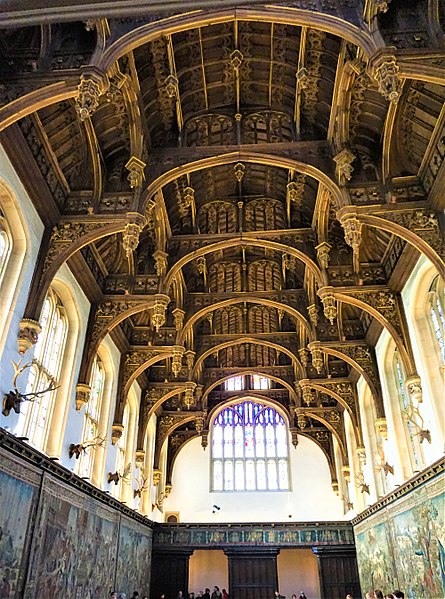
There are also ten statues of heraldic animals, called the King’s Beasts, that stand on the bridge over the moat leading to the great gatehouse. Unlike the Queen’s Beasts in Kew Gardens, these statues represent the ancestry of King Henry VIII and his third wife Jane Seymour. The animals are: the lion of England, the Seymour lion, the Royal dragon, the black bull of Clarence, the yale of Beaufort, the white lion of Mortimer, the White Greyhound of Richmond, the Tudor dragon, the Seymour panther, and the Seymour unicorn. The set of Queens Beasts at the Coronation of Queen Elizabeth II replaced the three Seymour items and one of the dragons by the griffin of Edward III, the horse of Hanover, the falcon of the Plantagenets, and the unicorn of Scotland.
還有十個紋章動物的雕像,稱為國王的野獸,站在通往大門樓的護城河上的橋上。 與邱園中的女王野獸不同,這些雕像代表亨利八世國王和他的第三任妻子簡西摩的血統。 動物是:英格蘭的獅子,西摩獅子,皇家龍,克拉倫斯的黑公牛,博福特的耶魯,摩梯末的白獅子,里士滿的白靈緹犬,都鐸王龍,西摩豹,以及 西摩麒麟。 女王伊麗莎白二世加冕儀下的皇后野獸取代了愛德華三世的獅鷲,漢諾威的馬,Plantagenets的獵鷹和蘇格蘭獨角獸的三個西摩項目和其中一條龍。
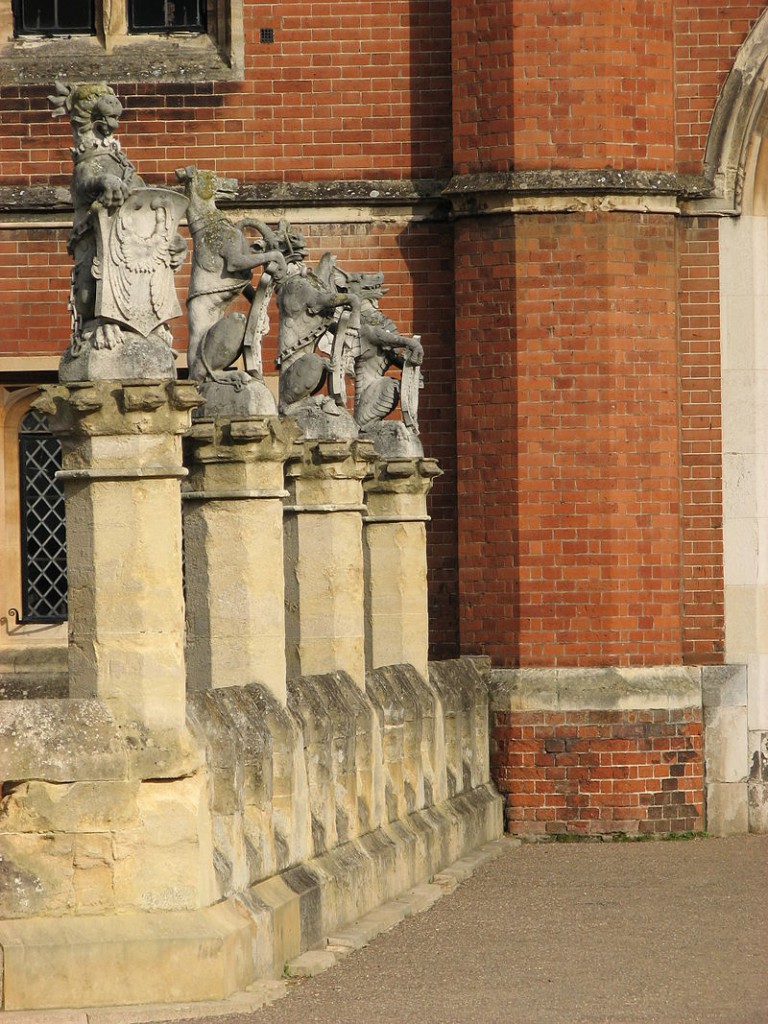
Since the reign of King George II, no monarch has resided at Hampton Court. In fact, George III, from the moment of his accession, never set foot in the palace: he associated the state apartments with a humiliating scene when his grandfather had once struck him following an innocent remark. He did however have the Great Vine planted here in 1763 and had the top two storeys of the Great Gatehouse removed in 1773.
In 1796, the Great Hall was restored and in 1838, during the reign of Queen Victoria, the restoration was completed and the palace opened to the public. The heavy-handed restoration plan at this time reduced the Great Gatehouse (A), the palace’s principal entrance, by two stories and removed the lead cupolas adorning its four towers. Once opened, the palace soon became a major tourist attraction and, by 1881, over ten million visits had been recorded. Visitors arrived both by boat from London and via Hampton Court railway station, opened in February 1849.
On 2 September 1952, the palace was given statutory protection by being grade I listed. Other buildings and structures within the grounds are separately grade I listed, including the early 16th-century tilt yard tower (the only surviving example of the five original towers); Christopher Wren’s Lion gate built for Anne and George I; and the Tudor and 17th-century perimeter walls.
The Royal School of Needlework moved to premises within the Palace from Princes Gate in Kensington 1987, and the Palace also houses the headquarters of Historic Royal Palaces, a charitable foundation.
自喬治二世國王統治以來,沒有君主居住在漢普頓宮。事實上,喬治三世,從他加入的那一刻起,就沒有踏上過宮殿:當他的祖父曾經在無辜的言論中擊中他時,他將國家公寓與一個令人羞辱的場景聯繫起來。然而,他確實在1763年種植了大藤,並在1773年拆除了大門樓的前兩層樓。
1796年,人民大會堂重建,1838年,在維多利亞女王統治時期,修復工作完成,宮殿向公眾開放。此時嚴厲的修復計劃將宮殿的主入口大門(A)減少了兩層樓,拆除了裝飾其四座塔樓的鉛圓頂。一旦開放,宮殿很快就成為一個主要的旅遊景點,到1881年,已經記錄了超過一千萬的訪問量。遊客從倫敦乘船到達漢普頓法院火車站,於1849年2月開通。
1952年9月2日,宮殿被列為一級,獲得法定保護。場地內的其他建築物和結構分別列為一級,包括16世紀早期的傾斜場塔(五座原塔唯一倖存的例子);克里斯托弗雷恩的獅子門為安妮和喬治一世建造;以及都鐸王朝和17世紀的圍牆。
皇家針線學校於1987年在肯辛頓的王子門搬到宮殿內,宮殿還設有慈善基金會歷史皇家宮殿的總部。
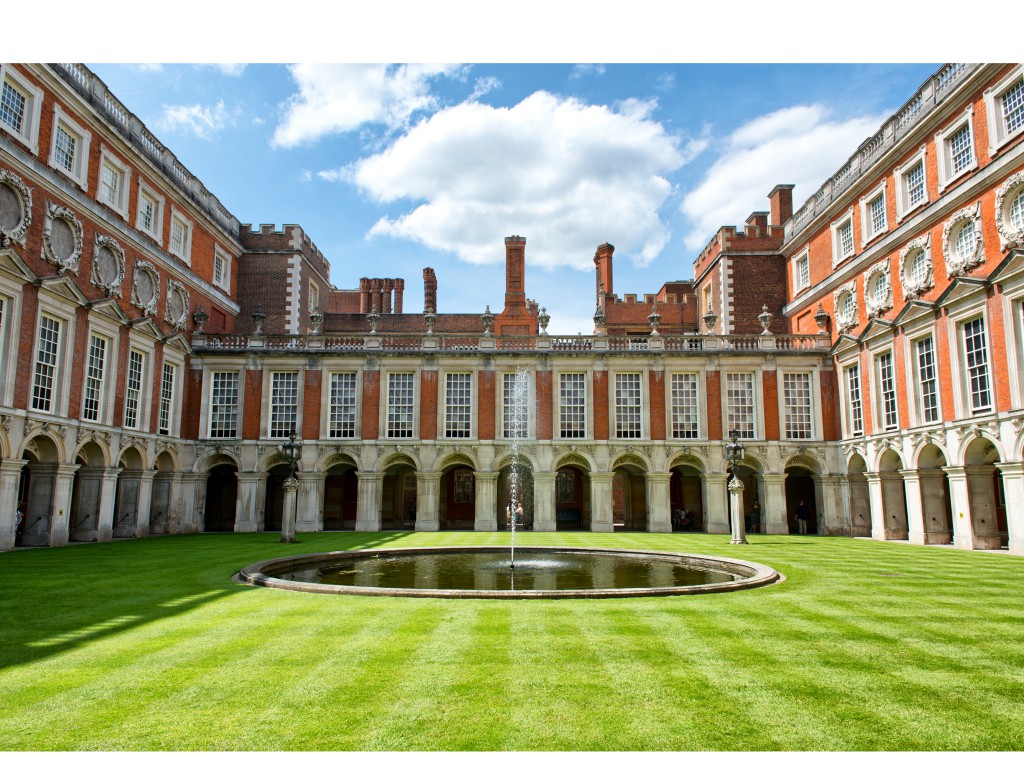
FROM:https://en.wikipedia.org/wiki/Hampton_Court_Palace
FROM:A Walk Around Hampton Court, Greater London
Don’t you think it’s addictive?
Want to know more about the beauty of architecture?
Come and join our members to explore the beauty of architectural design.
覺得看得不過癮嗎?
想要知道更多建築之美嗎?
快來加入我們的會員,一同探索建築設計之美。
The above article is purely for appreciation and sharing purposes, as well as the construction of new technology and the public can be in-depth understanding of the information at the same time there are sources, will be able to query, no use of the document as a commercial transaction, if illegal, please inform the We will immediately remove the site, thank you for cooperation.
以上文章純粹作為欣賞及分享用途,以及將建築新型技術傳遞給與大眾能夠深入了解,同時資料還有來源,將可查詢,絕無使用該文件資料作為商業交易行為,如有違法請務必告知該網站我們將立即處理撤除,謝謝合作。

